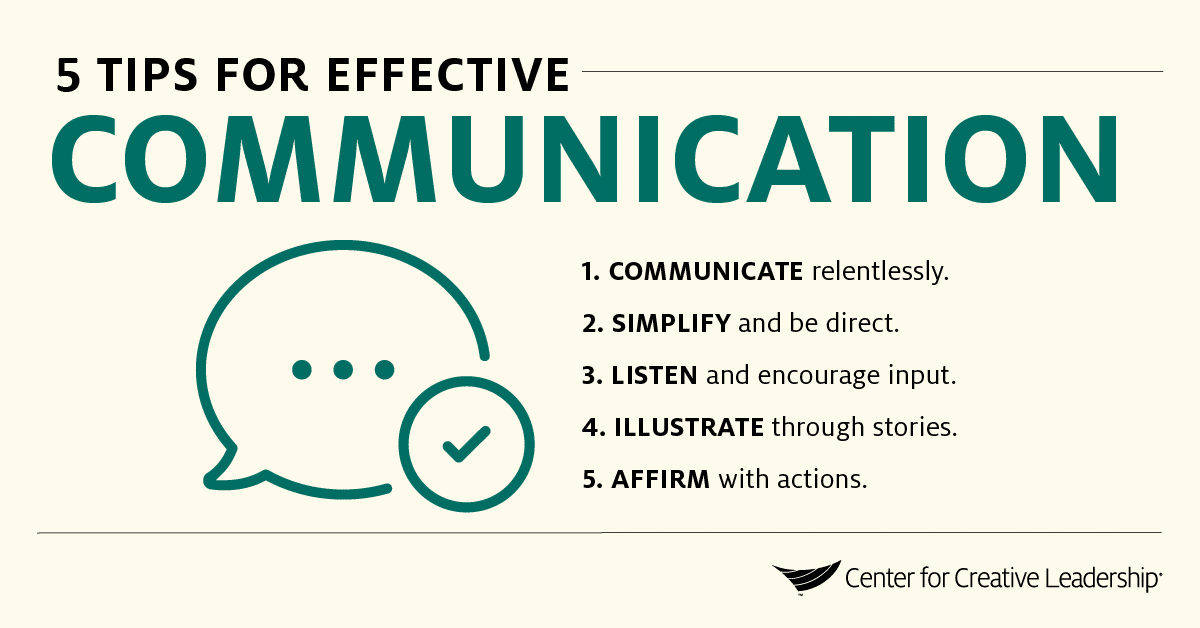Describing effective communication as a 2-way street is passé. Communication for leaders is much more complicated, and leaders at all levels need to know a whole lot more than the mechanics of sending and receiving information. Harnessing the ability to communicate effectively is one of the most important skills a leader can have.
Here are some important things to remember about communication for leadership:
Why Is Communication Important in Leadership?
It’s critical. Good communication is a core leadership function and a key characteristic of a good leader. Effective communication and effective leadership are closely intertwined. As a leader, you need to be a skilled communicator in countless relationships at the organizational level, in communities and groups, and sometimes on a global scale in order to achieve results through others.
You need to think with clarity, express ideas, and share information with a multitude of audiences. You must learn to handle the rapid flows of information within the organization, and among customers, partners, employees, and other stakeholders and influencers.
Leaders must be purposeful and intentional about effective communication. You must know how and when to communicate, and select the appropriate mode for your audience. In fact, there are 4 types of communication contexts, including writing, conversing, presenting, and facilitating — and leaders must excel in all of them. It’s the only way to meet people’s individual needs and enable important human connections.
3 Important Facts About Communication for Leaders
1. Authenticity counts — a lot.
Be honest and sincere. Find your own voice; quit using corporate-speak or sounding like someone you’re not. Let who you are, where you come from, and what you value come through in your communication. People want, respect, and will follow authentic leadership. So forget about eloquence — worry about being real. Don’t disguise who you are. People will never willingly follow someone they feel is inauthentic.
2. Visibility is a form of communication.
If you want to communicate well, don’t be out of sight. Don’t be known only by your emails and official missives. Be present, visible, and available. Getting “out there” — consistently and predictably — lets others know what kind of leader you are. People need to see and feel who you are to feel connected to the work you want them to do. Find ways to interact with all of your stakeholder groups, even (and especially!) if communicating in a crisis.
3. Listening is a powerful skill.
Good communicators are also good listeners. When you listen well, you gain a clear understanding of another’s perspective and knowledge. Listening fosters trust, respect, openness, and alignment. Active listening is a key part of coaching others. Allow people to air their concerns. Ask powerful questions that open the door to what people really think and feel. And pay close, respectful attention to what is said — and what’s left unsaid.
Bonus Fact: Contributing is just as important as receiving.
When a leader focuses on their contribution to the conversation, not just receiving their team’s deliverables, they learn more and help the team get closer to accomplishing shared goals. A skilled leader and effective communicator is not only good at transferring their own ideas, but also excels in aligning expectations, inspiring action, and spreading vision. Sometimes focusing on the “leave-behinds” is just as crucial as focusing on the “take-aways.”.
5 Critical Tips for Leaders to Communicate More Effectively

1. Communicate relentlessly.
Communicate information, thoughts, and ideas clearly — and frequently — in different media. Keep processes open and transparent, and find ways to help smooth the path of communication for your team, employees, or organization. Shed all traces of detachment and arrogance, and take the time to talk to your people.
2. Simplify and be direct.
Say what you mean. Be direct. Don’t hide behind complexity or pile on a ton of information. Direct communication can be the most important type of communication. This is even more important when communicating in a virtual setting.
3. Listen and encourage input.
Pause. Be okay with silence. Encourage the other person to offer ideas and solutions before you give yours. Do 80% of the listening and 20% of the talking. And showing interest in, and respect for, your colleagues will help you build trust and make the emotional connection that’s so important for effective leadership. Let team members know they are valuable, show empathy, and create psychological safety so people feel comfortable speaking up. It will show those you lead that you care about both them and the organization.
4. Illustrate through stories.
When you tell a good story, you give life to a vision, goal, or objective. Telling good stories creates trust, captures hearts and minds, and serves as a reminder of the vision. Plus, people find it easier to repeat a story or refer to an image or quote than to talk about a mission statement, strategy document, or project plan. This is key when communicating the vision.
5. Affirm with actions.
While effective leaders master the art and craft of language, speaking clearly, and presenting logical and compelling arguments, skilled leaders also know that communication goes beyond words. If people hear one thing from you and see another, your credibility is shot. People need to trust you. Your behavior and actions communicate a world of information — so focus on alignment and be clear on the messages you send even when you aren’t saying anything.
Leaders Communicate With Actions and Attitude, Too
At a very basic level, communication is the transmission of information between a sender and a receiver. But realize that your attitude and actions give additional meaning to your spoken and written messages. Your behavior gives people information about your disposition, opinion, or mood — regardless of the words you speak.
Communication can disclose the leader’s authenticity, sincerity, and virtually every other aspect of a leader’s character. When a leader is all talk and no substance, people see right through the official message.
So what does a leader’s communication style say about their character?
Consider what great leaders do when they communicate. They:
- Handle resistant audiences well;
- Choose effective tactics to influence people;
- Listen to individuals from all levels of the organization;
- Encourage direct and open discussion;
- Initiate difficult, but needed conversations;
- Are clear about expectations and ask good questions; and
- Involve others before developing a plan of action.
So, to be more effective in communication, think not only about your words, but also about your attitude and actions, too. It will make a huge difference to your people — and your organization.
>Here are some additional recommendations to consider for leaders who are seeking to enhance their communication via actions and attitude:
1. Reinforce intent with body language.
Positive body language like eye contact, nodding, and other relaxed gestures can inspire team members and make them feel more comfortable communicating with you. A simple head nod or smile can go a long way to show you’re paying attention and that you care, and little gestures like this can add up, slowly helping to transform your organizational culture, too.
2. Encourage feedback — and then take it seriously.
Asking for honest feedback from your team or employees can foster a positive stream of communication, and it helps build trust overall. This tactic can also make your team feel more respected, giving them a chance to have their voices heard. If you take their feedback seriously, you will grow as a leader and enhance your skillset. However, if you ask for and then don’t incorporate their feedback, the opposite is true — it could lead to a loss of trust and alignment.
3. Protect your reputation.
It’s important that you don’t compromise your reputation for the sake of communication. At times, you may walk a fine line between being too aggressive and being too relaxed, and as a leader, you need to make sure you don’t get a reputation for leaning too heavily in one direction.
To navigate these challenges, consider asking yourself thought-provoking questions like “When do I stay out of an issue and when do I get involved?” or “How do I respond when errors are identified?” Make a list of communication concerns you have, and ask a colleague to describe the behaviors they would consider too aggressive or too relaxed — their responses will help you gauge how to move forward.
4. Create a compelling story.
People connect best with stories. To be an effective communicator, you will need to craft a compelling story and vision, and make sure it’s communicated well. Your vision should be inspiring, short and to the point, and authentic and bold. Your ability to create and communicate a compelling story will help you bolster your leadership brand.
What Poor Leadership Communication Costs Your Organization
Workplace communication is a moving target. Leaders must continue to find new ways to make their communications more effective, purposeful, and trustworthy. But, what if communication becomes stagnant, unorganized, and messy?
Leaders may unintentionally derail their own efforts to enhance communication. They may not communicate enough because of a fear of oversharing, they may think out loud at the wrong moment, or they may have been too honest with a colleague.
These challenges typically arise in high-stress situations, when expectations or deadlines aren’t met, when an opportunity is lost, or when innovation is lacking. It can be frustrating, but it’s worth putting in the extra effort to tackle these conflicts head-on with candid conversations and productive debate, because when a conflict is mismanaged, costs will continue to mount — whether they result in tangible out-of-pocket costs like turnover, or intangible costs like poor morale, decision-making, or broken trust.
How Effective Leadership Communication Builds Trust
A strong foundation of trust is one of the quickest ways leaders can establish good communication. Here are some actions that you can take while communicating to build trust. As you’re reading them, rate yourself on a scale of 1 to 5 — with a 1 signifying it’s an area that you need to work on, and 5 meaning that you have excelled:
- Ensure that your words and actions are consistent and avoid mixed messages.
- Act in ways that support the values of your organization.
- When having difficulty with another coworker or team member, go directly to that individual to discuss the situation.
- Be a sounding board on sensitive issues for others.
- Share your own opinions and perspectives, even when they’re different from the majority view.
- Avoid being a “yes” person.
- Keep your focus on the big picture and the shared goals of the organization.
- Accept accountability for your own actions and the results of those actions.
- Promote respectful dialogue and productive debate, and work to resolve conflicts productively.
Now that you’ve assessed your skills, how high is your score? How well did you do? If you identified any areas that need improvement, begin today by marking the one that you will start with immediately to start building trust and improving your communication as a leader.
Author
Originally posted in CCL’s Leading Effectively Blog. Eckerd College has been a network associate of CCL since 1981.




